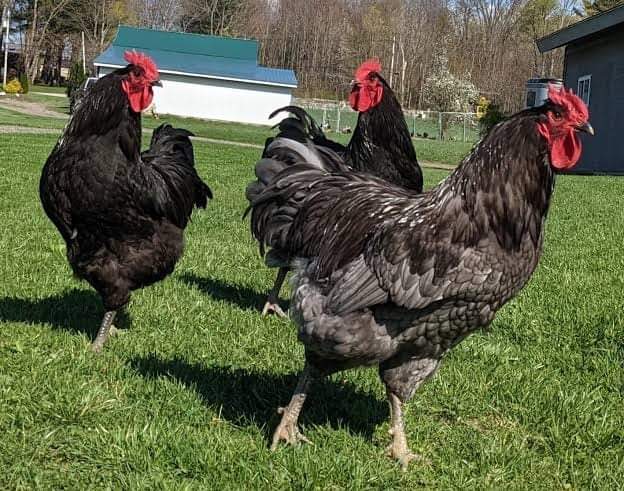History and Origin Of Jersey Giant
The Jersey Giant is a remarkable and well-known chicken breed, revered for its size, utility, and docile temperament. Developed in the United States during the late 19th century, this breed is popular among poultry enthusiasts, homesteaders, and farmers for both meat and egg production. Below is an intensive note covering the history, characteristics, care, and benefits of this exceptional breed.
History and Origin
The Jersey Giant was developed in New Jersey, USA, around the 1870s by John and Thomas Black. Their goal was to create a chicken breed that could rival turkeys in size and meat production. They achieved this by crossing several large breeds, including Black Langshans, Black Javas, and Dark Brahmas. The breed was initially intended to meet the demand for large meat birds before the widespread adoption of commercial broilers.
The American Poultry Association (APA) officially recognized the Jersey Giant in 1922, starting with the Black variety, followed by the White in 1947.
Physical Characteristics
Size and Weight
The Jersey Giant is the largest chicken breed in the world. Adult males (roosters) weigh between 13–15 pounds, while hens weigh between 10–12 pounds.
Color Varieties
The breed comes in three primary color varieties:
Black: Glossy, greenish-black feathers.
White: Pure white feathers.
Blue: A slate-blue coloration with darker lacing.
Body Structure
Jersey Giants have a broad, deep body with a sturdy, muscular build. Their large size makes them slower growers compared to other breeds. They typically reach full maturity at around 16–18 months.
Combs and Wattles
They have a single comb with five to six well-defined points and medium-sized wattles, both of which are red. Their shanks and feet are typically black or slate gray.
Egg Production
Although primarily a meat bird, Jersey Giants are also respectable egg layers.
Egg Size and Color: They lay large, brown eggs.
Production Rate: Hens can produce approximately 150–200 eggs annually, which is moderate but reliable.
Seasonality: They are consistent layers, even during the winter months, due to their hardiness.
Temperament and Behavior
Jersey Giants are known for their calm and friendly nature, making them excellent for family farms.
Docility: They are gentle giants and are easy to handle.
Compatibility: They get along well with other chickens and are less likely to show aggression.
Care and Management
1. Housing Requirements
Due to their size, Jersey Giants need larger coops and nesting boxes. Allow at least 4–5 square feet per bird inside the coop and ample outdoor space for foraging.
2. Diet and Nutrition
A high-protein feed (16–20%) is essential during their growth phase to support their larger frame.
Supplement with grains, greens, and occasional treats.
3. Health Considerations
They are generally hardy but require proper footing in wet or muddy areas to prevent leg and joint issues.
Keep an eye on their weight, as excessive size can lead to mobility problems.
4. Climate Adaptability
They tolerate cold weather well, thanks to their size and feathering.
In hot climates, ensure adequate shade, ventilation, and fresh water to prevent heat stress.
Advantages of Jersey Giants
Dual-purpose Utility: Excellent for both meat and egg production.
Hardiness: Adaptable to various climates and resistant to common poultry diseases.
Low Maintenance: Their docility and independent foraging make them easy to manage.
Winter Laying: Consistent egg production even in colder months.
Challenges
Slow Growth: They take longer to reach full maturity, which may not suit commercial meat production.
Space Needs: Their larger size requires more room, which could be a constraint for smaller farms.
Feed Costs: Their substantial size means they consume more feed than smaller breeds.
Is the Jersey Giant Right for You?
The Jersey Giant is an excellent choice for anyone seeking a dual-purpose breed with a friendly demeanor and impressive size. Whether for sustainable farming, homesteading, or as a unique addition to a backyard flock, this breed offers utility and charm. However, potential owners should be prepared to provide sufficient space and proper nutrition to support their growth and well-being.
By carefully managing their care and appreciating their qualities, the Jersey Giant can be a valuable and rewarding addition to your poultry venture.




